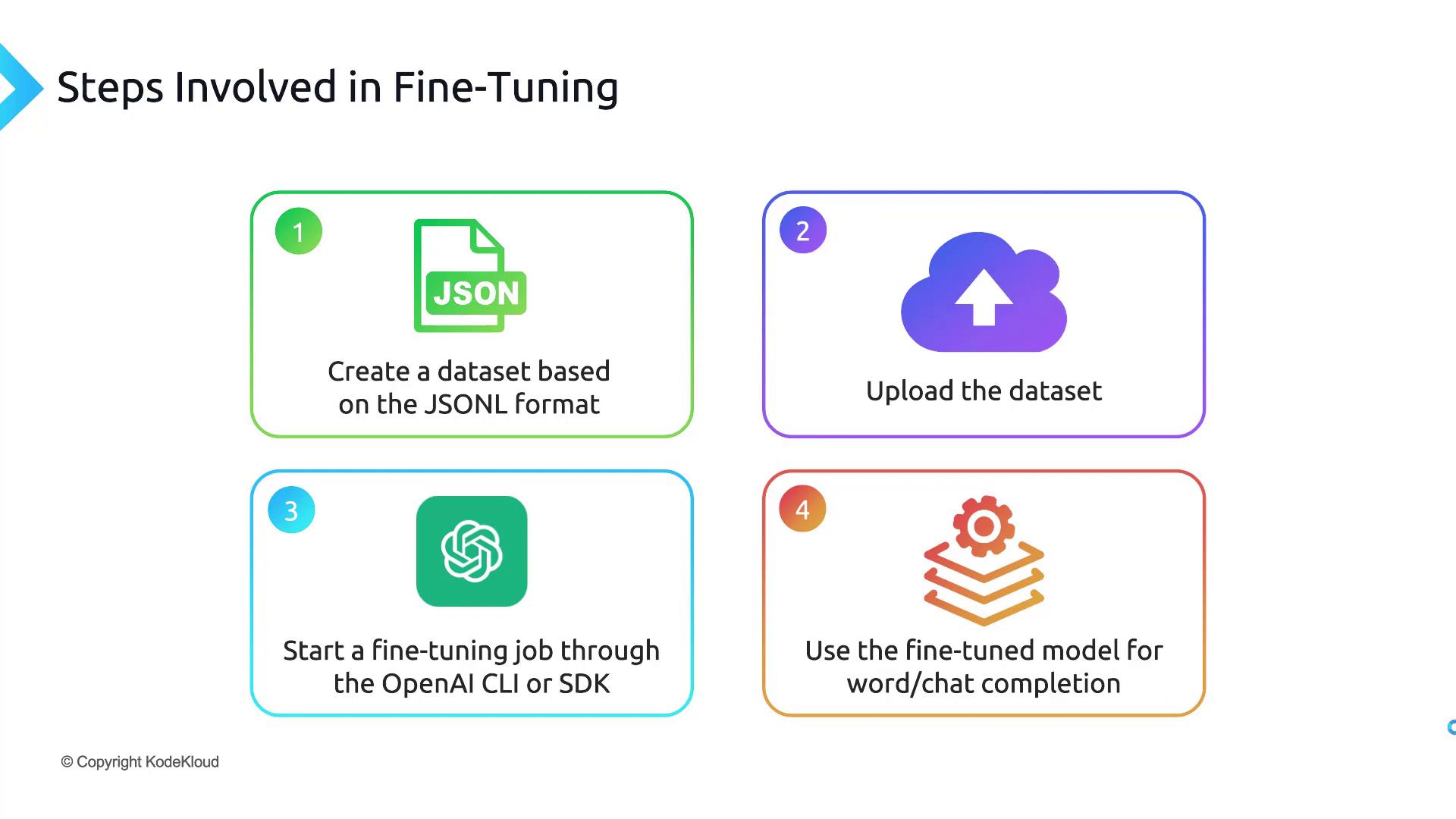Mastering Generative AI with OpenAI
Fine tuning GPT 3 with a Custom Dataset
Steps Involved in Fine Tuning a Model
Fine-tuning an OpenAI model involves four core phases: preparing your data, uploading & validating it, launching a training job, and then calling your custom model. This guide walks through each step, from creating a JSONL dataset to selecting a cost-effective base model.

1. Prepare Your Dataset in JSONL Format
OpenAI fine-tuning requires a line-delimited JSON (JSONL) file. Each line should be a valid JSON object with two keys—prompt and completion—terminated by a stop token (e.g., END).
Note
Ensure each JSON object is newline-delimited (no commas between lines) and ends with your chosen stop token.
Example qna.jsonl:
{"prompt": "Question: What is AI? ->", "completion": "AI stands for artificial intelligence.\nEND"}
{"prompt": "Question: Define machine learning ->", "completion": "Machine learning is a subset of AI focused on data-driven models.\nEND"}
Fields:
- prompt: The user’s input or instruction.
- completion: The desired response, ending with
END.
You can handcraft this file or generate it via scripts or even using a base model like ChatGPT, then export it to .jsonl.
2. Upload & Validate Your JSONL Dataset
Before training, preprocess and upload your dataset using the OpenAI CLI:
pip install --upgrade openai
openai tools fine_tunes.prepare_data -f qna.jsonl
This command:
- Checks for JSONL formatting issues.
- Removes duplicate entries.
- Produces a cleaned file named
qna_prepared.jsonl.
3. Launch & Monitor the Fine-Tuning Job
Submit the prepared dataset to fine-tune a base model (e.g., davinci):
openai api fine_tunes.create \
-t qna_prepared.jsonl \
-m davinci
You’ll receive a fine_tune_job_id. Track progress with:
openai api fine_tunes.follow -i <FINE_TUNE_JOB_ID>
Job durations vary based on data size and model choice—it can take minutes or hours.
4. Query Your New Fine-Tuned Model
After completion, you’ll get a model ID like davinci:ft-your-org-2024-06-01-00-00-00. Test it via the Completions API:
openai api completions.create \
-m <FINE_TUNED_MODEL_ID> \
-p "Question: What is AI? ->" \
--stop "END"
Use this same pattern for tasks such as summarization, classification, or conversational agents.
5. Base Model Selection & Cost Comparison
Choosing the right base model balances performance and budget. Review the table below:
| Base Model | Price (1K tokens) | Context Window | Ideal Use Case |
|---|---|---|---|
| Ada | $0.0004 | 2,048 tokens | Simple classification |
| Babbage | $0.0005 | 2,048 tokens | Moderate Q&A |
| Curie | $0.0020 | 2,048 tokens | Summarization & chat |
| Davinci | $0.0200 | 4,096 tokens | Complex reasoning tasks |
Warning
Fine-tuning costs include both training and usage. Always check the OpenAI pricing page and monitor your token consumption to avoid unexpected charges.
Links and References
- OpenAI Fine-Tuning Guide: https://platform.openai.com/docs/guides/fine-tuning
- OpenAI Pricing: https://openai.com/pricing
- JSONL Specification: https://jsonlines.org/
- OpenAI CLI Reference: https://github.com/openai/openai-cli
With this end-to-end workflow—dataset preparation, validation, training, and model invocation—you’re ready to fine-tune any future OpenAI model for your custom use cases.
Watch Video
Watch video content